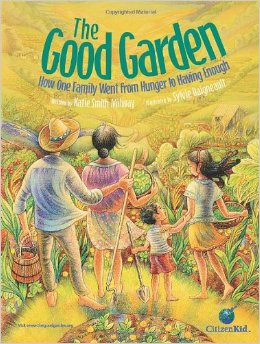When the exhausted soil of their family plot doesn’t yield enough and her father leaves to find work, María Luz plants the winter vegetables using new farming techniques she learns from her teacher, Don Pedro. Marigolds repel insect pests. Terracing and using compost and nutrient-fixing crops improve the soil so much that their garden can sustain her family again. This encouraging story by the author of One Hen (illustrated by Eugenie Fernandes, 2008) honors the work of Honduran farmer-trainer Elías Sanchez. Full-bleed illustrations, curving lines done with colored pencil on colored paper, extend across the gutters to show María Luz, her family and neighbors at work, the threatening coyote who wants to sell their produce and take his cut and the busy market where they sell cash crops and buy seed on their own. The sun waves long arms and beams at the improvement in their lives.
The end of the book has information about food security around the world and include a glossary of Spanish words (Kirkus Reviews, 2014). The book also provides children with tools and information to make a difference, locally, and globally through its interactive website: www.thegoodgarden.org. Interest level is 3-5 Grade and the genre is sustainable agriculture, environmental sustainability. This story responds to one of the core aspects about EJE, which is the protection of the protection of the environment through proper agricultural practices so future generations can equally benefit. How could you encourage your students to learn sustainable and traditional agriculture practices in their own SEMIS projects? What cultural approaches to agriculture would you like to learn about with your students?
*Thank you to Linda Williams and SEMIS graduate students for contributing to this post!*

